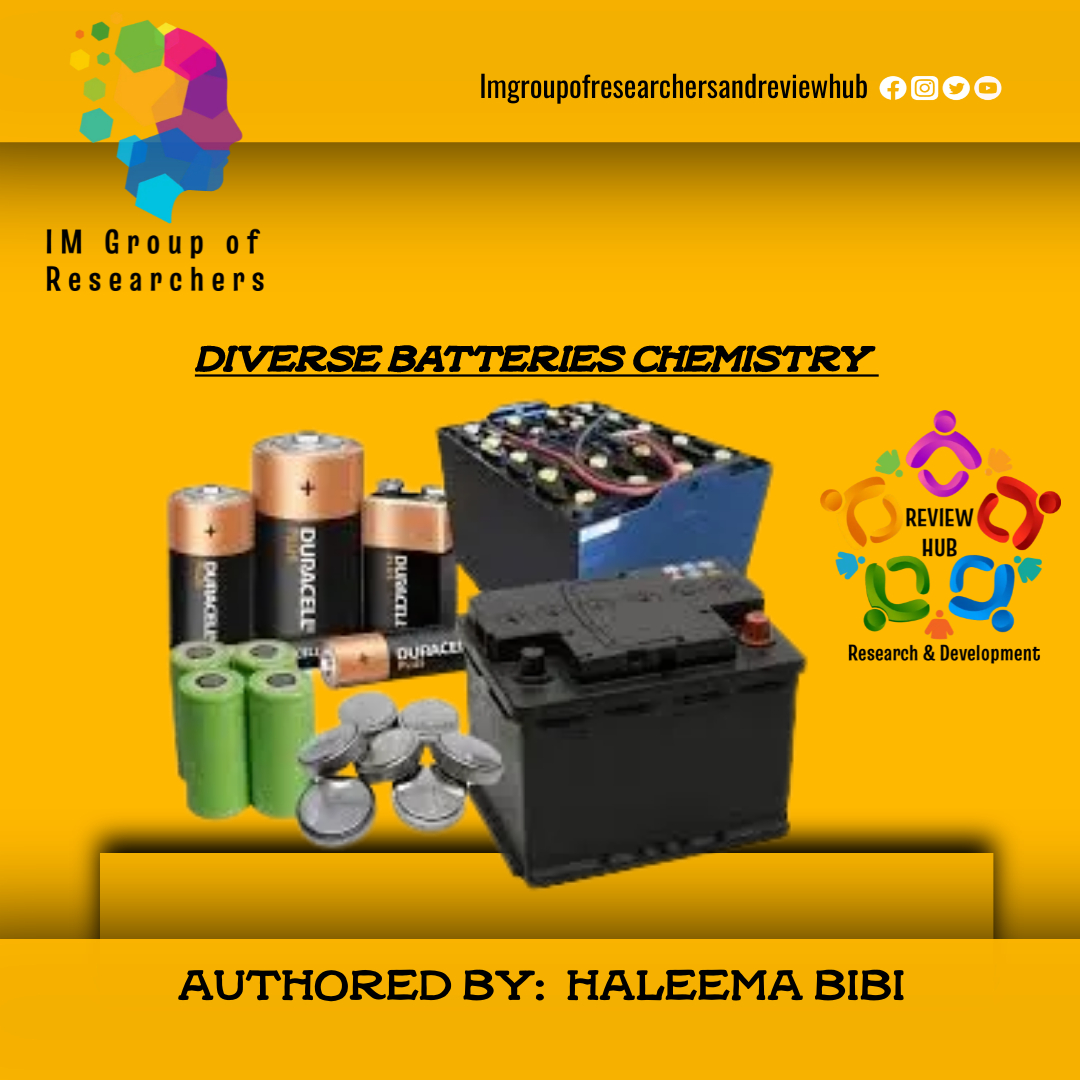Different battery chemistries are becoming more and more noteworthy as we work to advance more effective and bearable energy storage choices. This blog piece on Diverse Batteries Chemistry examines the new technologies, their potentials, and the complications they may encounter.
Author: Haleema Bibi
1. Introduction to Alternative Battery Chemistries
1.1. The Prerequisite of Non-Recyclable Batteries
The limitations of outdated lithium-ion batteries have been made clear by the progress of electric automobiles (EVs) and renewable energy sources. Alternate chemistries that offer effective, safe and justifiable energy storage solutions are decisive in light of problems including resource insufficiency, environmental influence, and safety concerns.
1.2. Swift of Up-to-Date Battery Machineries
These days, lithium-ion batteries are in claim because of their countless proficiency and energy thickness. However, because of their flammability and dependance on rare raw materials like cobalt and lithium, they present protection issues. These boundaries highlight how vital it is to fashion substitute batteries.
2. Battery made of sodium-ion
2.1. Prosperity and Less Costly
Sodium-ion batteries are reasonable substitute for lithium as they run on Na, which is plentiful and less expensive. Because Na is commonly available, supply chain risks and costs are abridged, which makes sodium-ion sets a striking option for large-scale requests.
2.2. Effectiveness and Productivity
While lithium-ion batteries have an advanced energy density than sodium-ion batteries, further investigation is making sodium-ion batteries more operative and competent. The charge capacity and sequence life of conducting materials and electrolytes are being upgraded by industrial advancements.
2.3. Utilizations and Prospects
When it comes to grid storage, where lifespan and affordability are more important than energy density, sodium-ion batteries are perfect. They are also being studied for use in movable integrated circuit technology and EVs, where their compact cost and improved safety are chief benefits.
3. Batteries made on lithium iron phosphate (LFP)
3.1. Safety Advantages
Associated to other lithium-ion batteries, LFP batteries are harmless since they are thermally firm and have a slighter chance of warmness and fire. They are perfect for large-scale usages like energy storage systems and EVs because of their safety.
3.2. Sturdiness and Ageing
Continuing and robust, Lithium-Polymer (LFP) batteries are supreme for long-lasting tenders. They have an extensive functioning lifespan since they can endure thousands of charge and discharge cycles with no loss of capacity.
3.3. Market Adoption
LFP batteries are appealing more and more common, particularly in the EV sector. LFP technology is being merged into vehicles by corporations such as BYD and Tesla, representing that this technology has the possibility to be widely used.
4. Batteries in Solid State
4.1. Innovation in Technology
Solid-state batteries propose improved protection and an advanced energy density by stand in for a solid electrolyte for a liquid one. This creation can significantly encompass the life of batteries and eliminate the risk of flammability that arises with liquid electrolytes.
4.2. Challenges in Development
Solid-state batteries have substantial manufacturing charges and glitches with quantifiable stability in spite of their probability. To get around these hindrances, current research is focused on generating stable solid electrolytes and creation techniques that are inexpensive.
4.3. Predictions for the Forthcoming
For high-performance usages, such as electric automobiles and transportable devices, solid-state batteries have probability. As research grows, these batteries, which outstrip conventional lithium-ion batteries in terms of performance and protection, may find widespread use.
5. Flow Batteries
5.1. Unique Design and Operation
Flow batteries enable scalable energy storage options by storing energy in liquid electrolytes housed in external tanks. Flow batteries are perfect for big applications since their architecture allows for easy scaling by simply increasing the size of the electrolyte tanks.
5.2. Advantages for Grid Storage
Flow batteries’ extended cycle life and scalability make them especially well-suited for grid storage. They offer dependable, long-term energy storage, which is necessary to balance sporadic renewable energy sources like wind and solar power.
5.3. Current Research and Development
The goal of research is to lower the cost and increase the efficiency of flow batteries. Enhancing performance and economic feasibility are the main goals of progress in electrolyte chemistry and membrane technology.
6. Batteries with Zinc Air
6.1. Advantages for the Environment
Zinc-air batteries are harmless and environmentally benign since they use zinc and oxygen from the air. Likened to other battery attractions, the resources have a lesser environmental consequence since they are abundant and non-toxic.
6.2. Density of High Energy
Because of its high energy density, zinc-air batteries are useful for applications requiring small, light energy storage. They are appropriate for wearable and portable electronics because they have the capacity to store more energy per unit weight than many other battery types.
6.3. Commercial Viability
Air-Zinc B Difficulties in commercializing zinc-air batteries include electrode deterioration and air management. These problems are being researched further in an effort to make zinc-air batteries a competitive and useful energy storage option.
7. Batteries using magnesium ion
7.1. Abundance and Safety
Magnesium is a viable substitute for lithium since it is more plentiful and safer to work with. Magnesium-ion batteries reduce prices and risks in the supply chain by using abundant, non-toxic ingredients.
7.2. Performance Characteristics
Despite magnesium-ion batteries’ poorer energy density than lithium-ion batteries, efforts are being made to enhance their functionality. To improve cycle life and charge capacity, developments in cathode and electrolyte materials are necessary.
7.3. Potential Applications
Applications where cost and safety are more important than energy density are best suited for magnesium-ion batteries. Because of their inherent safety benefits, they are being investigated for application in consumer electronics and stationary energy storage systems.
8. Silicon Anode Batteries
8.1. Enhanced Capacity
Since silicon anodes can grasp more lithium ions, they can vividly boost battery capacity. This development may result in batteries with meaningfully improved energy densities, growing the EVs’ and moveable gadgets’ range and functioning time.
8.2: Difficulties and Resolutions
During cycles of charge and discharge, silicon anodes encounter difficulties such as volume expansion and structural damage. To solve these problems and increase durability, researchers are using composite materials and nano structuring.
8.3. Scenarios for the Future
Lithium-ion expertise may undertake a revolution because to silicon anode batteries, which promise outstanding gains in performance and energy density. These machineries have the likelihood to be important fragments of the energy storage arrangements of the forthcoming as they progress.
9. Batteries/Series made of lithium sulfur
9.1 Density of High Energy
Because lithium-sulfur batteries have an advanced energy density than old-style lithium-ion batteries, they are a needed option for insignificant, light energy storage devices like power-driven aircraft and drones.
9.2 Eco-friendly Impacts
Because sulfur is abundant and non-toxic, lithium-sulfur batteries are well for the environment. Sulfur use lessens dependency on costly and rare elements, which might cut total battery prices.
9.3. Operational Complications
One of the complications in evolving lithium-sulfur batteries is the polysulfide shuttle, which outcomes in capacity drop. To get around these difficulties and expand performance, researchers are looking for at protective coverings and cultured electrolyte conformations.
10. Batteries with aluminum ions
10.1. Abundance and Cost
Aluminum is low-priced and broadly available, making it a extra affordable option than Li. Aluminum-ion batteries have the possibility to lessen total battery charges for a diversity of applications by presenting more reasonable rated energy storage alternatives.
10.2: Effectiveness and Productivity
Aluminum-ion batteries have limitless potential for high-performance applications, even if they are still in the initial phases of investigation. To make these successions competitive, researchers are concentrating on growing energy density and charge-discharge effectiveness.
10.3. Research Directions
The expansion of suitable electrolyte and cathode constituents for aluminum-ion batteries is the core focus of existing research. Future applications will be possible by novelties in these fields, which are crucial for enhancing performance and marketable feasibility.
11. Batteries Based on Graphene
11.1. Revolutionary Materials
Because of its extraordinary machine-driven and electric qualities, graphene is being examined for use in next-generation batteries. Its strength and strong conductivity present a promising opportunity for major breakthroughs in battery technology.
11.2. Enhanced Conductivity
Battery conductivity and capacity are increased by graphene, which results in notable performance gains. Higher energy densities and quicker charge times can be achieved by integrating graphene into battery electrodes.
11.3. Applications and Future Research
Batteries built on graphene show promise for a variety of uses, including EVs and portable devices. Current research endeavors to surmount obstacles related to large-scale production and integration, hence advancing the commercial viability of these batteries.
12. Conclusion
12.1. Battery Technology’s Future
The field of energy storing will endure a revolution for the reason to substitute battery chemistries. These improvements address the inadequacies of present technology and promise innocuous, more operative, and greener batteries.
12.2 Continuing Towards Environmental Balance
Alternative battery interactions will be important to promising a sustainable future as the world moves to electrification and renewable energy. These novelties provide a way onward for a cleaner, greener society by lessening dependency on fixed resources and enhancing battery performance.
Also read: Biopesticides: Using Organic Remedies for Long-Term Pest Management
Follow Us on

